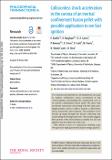Files in this item
Collisionless shock acceleration in the corona of an inertial confinement fusion pellet with possible application to ion fast ignition
Item metadata
| dc.contributor.author | Boella, E. | |
| dc.contributor.author | Bingham, R. | |
| dc.contributor.author | Cairns, R. A. | |
| dc.contributor.author | Norreys, P. | |
| dc.contributor.author | Trines, R. | |
| dc.contributor.author | Scott, R. | |
| dc.contributor.author | Vranic, M. | |
| dc.contributor.author | Shukla, N. | |
| dc.contributor.author | Silva, L. O. | |
| dc.date.accessioned | 2020-11-06T11:30:37Z | |
| dc.date.available | 2020-11-06T11:30:37Z | |
| dc.date.issued | 2021-01-25 | |
| dc.identifier | 271083483 | |
| dc.identifier | dea93dc3-e27b-49a4-a333-443792587ce1 | |
| dc.identifier | 000598829700009 | |
| dc.identifier | 85097285451 | |
| dc.identifier.citation | Boella , E , Bingham , R , Cairns , R A , Norreys , P , Trines , R , Scott , R , Vranic , M , Shukla , N & Silva , L O 2021 , ' Collisionless shock acceleration in the corona of an inertial confinement fusion pellet with possible application to ion fast ignition ' , Philosophical Transactions of the Royal Society. A, Mathematical, Physical and Engineering Sciences , vol. 379 , no. 2189 , 20200039 . https://doi.org/10.1098/rsta.2020.0039 | en |
| dc.identifier.issn | 1364-503X | |
| dc.identifier.other | Jisc: d5cfb5325e724f598658bdd046a92fa7 | |
| dc.identifier.other | Jisc: d5cfb5325e724f598658bdd046a92fa7 | |
| dc.identifier.other | ORCID: /0000-0001-5624-5128/work/87403987 | |
| dc.identifier.uri | https://hdl.handle.net/10023/20916 | |
| dc.description | Funding: This work was partially supported by the UK Engineering and Physical Sciences Research Council (grants no. EP/N013298/1, EP/R004773/1 and EP/N028694/1). This work has also been carried out within the framework of the EUROfusion Consortium and has received funding from the Euratom research and training programme 2019–2020 (grant agreement no. 633053) and Eurofusion Enabling Research (grant no. ENR-IFE19.CCFE-01). M.V. acknowledges the support of the Portuguese Science Foundation (FCT) (grantno. SFRH/BPD/119642/2016). | en |
| dc.description.abstract | Two-dimensional particle-in-cell simulations are used to explore collisionless shock acceleration in the corona plasma surrounding the compressed core of an inertial confinement fusion pellet. We show that an intense laser pulse interacting with the long scale-length plasma corona is able to launch a collisionless shock around the critical density. The nonlinear wave travels up-ramp through the plasma reflecting and accelerating the background ions. Our results suggest that protons with characteristics suitable for ion fast ignition may be achieved in this way. This article is part of a discussion meeting issue ‘Prospects for high gain inertial fusion energy (part 2)’. | |
| dc.format.extent | 11 | |
| dc.format.extent | 1144611 | |
| dc.language.iso | eng | |
| dc.relation.ispartof | Philosophical Transactions of the Royal Society. A, Mathematical, Physical and Engineering Sciences | en |
| dc.subject | Inertial confinement fusion | en |
| dc.subject | Ion-driven fast ignition | en |
| dc.subject | Collisionless shock acceleration | en |
| dc.subject | QB Astronomy | en |
| dc.subject | QC Physics | en |
| dc.subject | TK Electrical engineering. Electronics Nuclear engineering | en |
| dc.subject | DAS | en |
| dc.subject.lcc | QB | en |
| dc.subject.lcc | QC | en |
| dc.subject.lcc | TK | en |
| dc.title | Collisionless shock acceleration in the corona of an inertial confinement fusion pellet with possible application to ion fast ignition | en |
| dc.type | Journal article | en |
| dc.contributor.institution | University of St Andrews. Applied Mathematics | en |
| dc.contributor.institution | University of St Andrews. Statistics | en |
| dc.identifier.doi | https://doi.org/10.1098/rsta.2020.0039 | |
| dc.description.status | Peer reviewed | en |
This item appears in the following Collection(s)
Items in the St Andrews Research Repository are protected by copyright, with all rights reserved, unless otherwise indicated.

